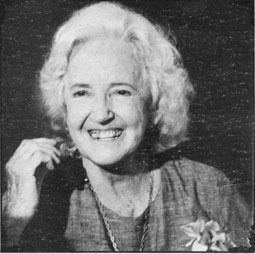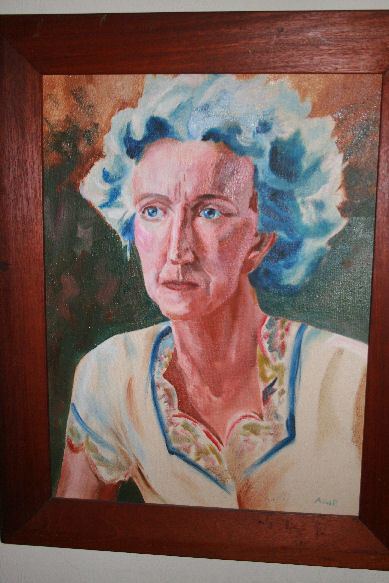Name Edna Manley | Children Michael Manley | |
 | ||
Artwork Negro Aroused, Pocomania, The Hills of Papine Parents Harvey Swithenbank, Ellie Shearer Similar People Norman Manley, Michael Manley, Rachel Manley, Peter Tosh | ||
Edna Swithenbank Manley, OM (1 March 1900 – 2 February 1987) was a sculptor and contributor to Jamaican culture. She was the wife of Norman Manley, the founder of the Jamaican People's National Party. She is often considered the "mother of Jamaican art".
Contents
- Edna Manley The Sculptor
- Early life and education
- Artistic life
- Negro Aroused the art piece
- Politics and art
- Death
- Edna Manley College of the Visual Performing Arts
- Works
- Awards
- Diaries
- References

Edna Manley: The Sculptor
Early life and education

Edna Manley was the daughter of English cleric Harvey Swithenbank and his Jamaican wife, Ellie Shearer. Her father died when Edna was nine, leaving his widow to raise their nine children by herself. Edna Manley was highly independent and spirited. She attended several art schools in a two-year period, as she sensed that these schools were incredibly limited in what they offered.
As a young woman, she took private art classes with the artist Maurice Harding. She went on to continue her art studies at the Regent Street Polytechnic as well as the Saint Martin's School of Art in London.
In 1921, she married her cousin, Norman Manley, and moved to Jamaica with him in 1922. They had two children, Michael Manley (a future prime minister) and Douglas Manley, a sociologist and minister in his brother's government.
Artistic life
Her move to Jamaica had a profound impact on her work. She abandoned studying zoology back in London, and her work took on a more "inspired formal elegance", according to Boxer. Manley's materials consisted mostly of native woods—she used yakka, mahogany, Guatemalan redwood, juniper cedar, and primavera. Some work dating from her first year on the island are "Beadseller", and "Listener". In describing "Beadseller", Boxer said, "It was as if in one fell swoop, nearly a hundred years of sculptural development had been bridged: in this, her first work done in Jamaica, Edna seems to have given expression to her ideas about contemporary British sculpture with which she had saturated herself prior to leaving England." Both pieces exhibited Manley's more progressive and cubist style.
Between 1925 and 1929, Manley softened some of her geometric forms, replacing them with more massive, rounded ones. Her son Michael was born during this time. "Market Women", a study of two voluptuous women sitting back to back, and "Demeter", a carving of the mythical Earth Mother, are indicative of Manley's late-1920s influence. The 1930s saw another change in her sculptural style. She tamed her early-1920s cubist lines with rounder influences, and produced a new, definitive style that lasted into the 1940s.
Jamaica was facing many political changes during the late 1930s and early 1940s. Members of the African diaspora were looking to do away with the aging colonial system that remained on the island. They were ready for a new social order, and voiced their displeasure with the colonial system by incurring strikes (along with riots), instigating food shortages, and promoting protest marches. Manley's work of the time reflected this civil unrest. Works like "Prophet", "Diggers", "Pocomania", and "Negro Aroused" "caught the inner spirit of our people and flung their rapidly rising resentment of the stagnant colonial order into vivid, appropriate sculptural forms," wrote poet M. G. Smith.
Her works were exhibited very frequently in England between 1927 and 1980. Her first solo exhibition in Jamaica was in 1937. The show marked a turning point in Jamaica's undeveloped art movement, and it prompted the first island-wide group show of Jamaican artists. Manley was also one of the founders of the new Jamaica School of Art. After premiering in Jamaica, her show opened in England, where it was received with much fanfare. It was the last time Manley's work would be shown in London for nearly 40 years.
Active for much of her life as an artist, she also taught at the Jamaica School of Art, now a component of the Edna Manley College of Visual and Performing Arts.
"Negro Aroused" - the art piece
While she was at London, Manley had discovered that the people of Jamaica had collected the money to buy her piece "Negro Aroused". Individuals pitched in whatever they could afford, purchasing the piece to begin a national art collection. She was highly moved by this act, partly because she claimed that it was such a difficult piece for her to create: "Negro Aroused,...was trying to create a national vision, and it nearly killed me, it was trying to put something into being that was bigger than myself and almost other than myself," Manley told Sculpture Review.
The original sculpture of "Negro Aroused" was created in 1935 and was first exhibited in 1937. From its exposure, "Negro Aroused" excited the public's imagination; it was acquired by public subscription and presented to the Institute of Jamaica to form a nucleus for an upcoming exhibition.
In 1977, work began to enlarge the sculpture and to create a monument to the workers of Jamaica and the Worker's Movement that was born in 1938. Edna Manley was commissioned to recreate the work in bronze, at a scale three to four times that of the original. She was assisted by several young sculptors. Prior to being shipped to New York for bronzing, the seven-foot version was destroyed in a warehouse fire.
In 1982, Manley produced a third version, closer in size to the original, but it incorporated some subtle changes she had introduced in the destroyed sculpture.
In 1991, the sculpture was posthumously enlarged by utilizing the "scaling up" technique of bronze foundries for the enlargement of a sculpture. The third version was selected because it was closer in size to the destroyed version. The cost was met by public subscription.
Politics and art
Norman Manley entered politics, and founded the People's National Party in 1938. Although Edna Manley was hesitant at first, she quickly accepted her husband's place—and her own—in Jamaican politics. She also designed The Rising Sun logo for the People's National Party. The beginning of Jamaica's new government-—and the fall of colonialism-—was reflected in Manley's work, which at the time dealt with the cyclical, birth-and-death themes of the sun and moon. Her work was also heavily influenced by the nature that surrounded her at Nomdmi, the mountain retreat she had built with her husband.
The 1950s and 1960s were quiet times for Manley as an artist. Her husband became more involved with politics, becoming the chief minister of Jamaica in 1955. Manley's responsibilities as the wife of a politician left little time for art. In 1958, she designed the Flag of the West Indies Federation. In 1965, she created a statue of Paul Bogle to commemorate his partaking in Jamaica's Morant Bay Rebellion. The statue was highly controversial because it was inherently the very first Jamaican public statue that depicted a black man. Manley also returned, in her personal carvings, to the animal sculptures that she did as a young woman.
In 1969, Edna's husband (Norman Manley) had been laid to rest. He had helped Jamaica to achieve total independence from Britain and self-government by 1962. Manley's carvings during this period were very personal—-reflections on her husband's death, her pain, and sense of loss. She retreated to the mountains and created "Adios," a piece interpreted as lovers in a last embrace, and "Woman," an agonized woman in reclusion. The end of this grieving period was marked by her creation of the triumphant "Mountain Women". She had accepted the loss of her husband. "I felt that because my roots were here in Jamaica, I could survive," she told Americas. "It was my return to the world after that period of intense grief."
After creating several more profound carvings, including "Faun", "Message" and "Journey", Manley gave her carving tools away to a young Jamaican sculptor and declared that she would never work with wood again. Instead, she worked with modeled terracotta or plaster casts. During the 1970s, the major themes of Manley's work were expressions of her "grandmother," or "old woman" image, of matriarchal society, and memories of her life with her husband Norman.
Manley continued to sculpt until her death in 1987. Although a great deal of her work was intensely personal, she created a body of sculpture that embodies Jamaican culture and spirit. English novelist Sir Hugh Walpole, a collector of her work, spoke at the opening of her 1937 London show. "There is a very strange and curious spirit there and Mrs. Manley has got within that strange spirit," he remarked. "There is in Jamaica a beauty that finds its expression through her, that comes partly from the Jamaican material she uses, partly from her own individuality, and partly also, I think, from the sort of sense of beauty that the different people of Jamaica themselves possess." For Manley, expressing the beauty of Jamaica was second nature. "I carve as a Jamaican for Jamaica," she told Americas, "trying to understand our problems and living near to the heart of our people."
Death
When Edna Manley died in 1987, she was accorded an official funeral and buried in the tomb of Norman Manley at the National Heroes Park, her work having earned her the unofficial title of "Mother of Jamaican Art".
Edna Manley College of the Visual & Performing Arts
Formerly the Jamaican School of Art, the school was renamed the Edna Manley College of the Visual & Performing Arts in 1995. The renaming of the institution was part of its reclassification as a tertiary institution. Edna Manley was selected in part because of her contributions to Jamaica's art, which included co-founding the school in 1950.
Works
Her works include: "Whisper"; "Into The Mist", "Before Thought ", "Moon", "Eve (Ceremonial Dance)", "Into The Sun", "Growth", "The Ancestor", "The Mother", "Negro Aroused", "Pocomania", "Diggers", "Man and Woman", "Bead Sellers ", "The Trees are Joyful", "Rainbow Serpent", "Rising Sun", "Prophet", "Ghetto Mother", "Mountain Women" and others mentioned above.
Awards
Manley received numerous awards including:
Diaries
Her granddaughter Rachel Manley edited her diaries which were published in 1998.
